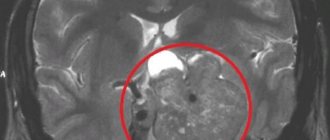Paranoia - what kind of disease is it, how does it affect the life of a person and the people around him. What is the urgency of the problem? What are the main causes and signs of paranoia, what is its differential diagnosis based on? Is it possible to effectively treat this disease? The answers to these questions are offered by the Chief Medical Doctor, practicing psychiatrist, psychiatrist-narcologist and psychotherapist Vladislav Sipovich.
What is paranoia and how relevant is its problem?
Paranoia, translated from Greek, literally means “next to the mind,” which can be regarded as a deviation from normal thinking towards exaggeration of one’s own personality and the ideas it produces while maintaining the logic of judgments. A person actually retains the ability to reason, but all his thoughts are aimed exclusively at proving his significance and recognition by society of his extremely valuable ideas. At the same time, self-criticism is practically absent, but the critical attitude towards people who do not share the idea of the exclusivity of the patient himself is literally off scale.
Paranoia is a rare type of chronic mental disorder that develops mainly in people who have reached adulthood. According to statistics, among patients undergoing treatment in psychiatric hospitals, the proportion of patients with paranoia is only 0.5-1%, and among all mental disorders it is 2-4%. Perhaps such low statistics are due to low detection, which in turn is associated both with the difficulty of differential diagnosis and with the patient’s non-recognition of his painful condition and maintaining the ability to integrate and function in society. A paranoid person is a person who is convinced of the value of his ideas and the prejudiced attitude of others. Attempts to prove the irrationality and unreality of the thoughts put forward by a paranoid only cause anger, distrust, hostility and even aggressiveness not only towards strangers, but also to close people themselves, as well as to specialists trying to help. Establishing contact with such a patient is extremely difficult and requires at the initial stage a partial recognition of the super-value and uniqueness of even the most crazy ideas. Paranoia is a disease that has such features as: • Gradual development without aggravating the pathological dynamics of symptoms and without increasing personality changes. In practice, this means the absence of apathy, decreased vitality, and abulia (loss of will and motivation). The patient’s nervous and energetic potential remains invariably high, aimed at achieving the goal, and internal dissatisfaction finds a way out in conflict with the outside world and the fight against imaginary injustice. • Logical validity and consistency of false ideas, which is almost impossible to refute. All objections have seemingly logical antitheses. • The theme of ideas is usually monodirectional, i.e. concerns a certain sphere of knowledge and activity of society. A classic example is graphomania, when a person, having once achieved the publication of his poems or stories, begins to consider himself an outstanding and unsurpassed poet or writer. The constant refusals of publishing houses to publish his “masterpieces” are perceived as the machinations of envious people, unprofessionalism and bias of editors, publishers, etc. It is almost impossible to prove the inconsistency of a paranoid’s claims, because he takes criticism as a personal insult and reacts with extreme hostility. Switching to another topic is uncharacteristic; the patient persistently achieves his goal and attacks various publishing houses ad infinitum. All these ordeals last for years and decades, causing extreme anger and hostility towards the whole world. • No hallucinations, e.g. distortions in the perception of reality. By the way, experts do not have a consensus on this matter; many sources acknowledge the existence of various types of illusions in paranoids, but usually these symptoms are observed in combined mental disorders, for example, paranoia-like delusions in schizophrenics. These phenomena have nothing to do with classical “pure” paranoia. • Consistent and generally predictable behavior based on the formal connection of many real elements with the false beliefs of the paranoid.
A patient with paranoia is characterized by extreme suspicion, blaming imaginary enemies for his failures, and a tendency to construct conspiracy theories against him in his imagination. The urgency of the problem is that one paranoid person can complicate the lives of many people, including not only those closest to him, but also those to whom he turns with his “projects”. The interests of a paranoid person include officials, specialized specialists, writers, directors, producers, public figures, judicial authorities, etc. Received refusals to satisfy requests and logical explanations do not stop the paranoid, but only strengthen his persistence. Sometimes he turns into a manic pursuer and may even descend to physical violence against those who refuse his protection.
Symptoms and diagnosis of the disease
Paranoid syndrome does not cause hallucinations, but a specialist can diagnose the pathological condition based on the characteristics of a person’s behavior.
People predisposed to paranoia already have one-sided interests at an early age. A characteristic feature of children is stubbornness and straightforward judgments. When growing up, the desire to lead is clearly evident, without taking into account the opinions of other people.
Paranoid people are unable to forgive even the most minor offenses and make compromises. They are characterized by a disdainful attitude towards others. Of course, with paranoid disorder a person has difficulty communicating with other people. All of these symptoms worsen with age.
In its advanced form, paranoia is characterized by systematized and logically constructed delusions. Most often, a person has a “fixed idea” that dominates consciousness and becomes a life goal. At the same time, the formation of a “super goal” occurs slowly in accordance with a certain logical chain, which makes it difficult to adjust from the outside.
Diagnosis of paranoia involves a conversation with a psychiatrist. The specialist’s goal is to collect anamnesis and identify symptoms characteristic of a paranoid state. After confirming the disease, the doctor determines the type of mental disorder and its form. Only after this the choice of treatment method is made.
What is the differential diagnosis of paranoia based on?
If earlier in classical psychiatry paranoia was considered for a long time as an independent disease, then according to the modern international classification of diseases, 10th revision (ICD-10), it is not classified as a separate category, but is classified under the subcategory of delusional disorder. Paranoia should be differentiated from similar paranoid (paranoid) personality changes. The latter often accompanies many mental disorders, in particular schizophrenia, paraphrenia, social phobias, anxiety disorders, post-traumatic stress and borderline states, and alcoholic psychoses. The difference between paranoia and paranoid personality disorders (hereinafter BPD): • Paranoia is characterized by following one idea, for example, if a paranoid person is convinced that a neighbor is harming him, then he will not communicate with him, maintaining communication with another environment. A hostile and aggressive attitude towards certain people develops when they do not recognize the patient’s highly valuable ideas and when they make critical statements about him. With paranoid disorder, distrust of everyone and everything comes to the fore; colleagues, the CIA, the FSB and the whole world can be the objects of distorted ideas. At the same time, the presence of an initial extremely valuable idea is not at all necessary. • Paranoia is always distinguished by a consistently constructed and logically connected system of ideas, which is based on the acceptance of some idea as an axiom that does not require proof. Otherwise, thinking retains its rationality and allows paranoids to exist and function normally in society. They usually do not make friends, but they can have family relationships. In BPD, delusions are unsystematized and inconsistent. • In paranoia there are no hallucinations or illusions. Paranoid disorder is characterized by a distorted perception of reality. • Paranoid disorders are much more common than paranoia. For example, in the USA, about 2-4% of the population suffer from more or less severe mental disorders of the paranoid type. This is due to the fact that the very concept of BPD is broader and includes paranoia itself, endogenous (paranoid schizophrenia) and exogenous (provoked by stress, an unusual situation, etc.) paranoid psychoses. • With BPD, there is a progressive change in personality, which can lead to complete disorganization of thinking, which is not typical for classical paranoia with the preservation of structure, consistency and logic of thought processes. • The cause of paranoia is unknown. There are only hypotheses about genetic predisposition, but the gene itself responsible for its development has not been found. An external trigger that starts a psychopathological process can be any event, which is extremely difficult to identify. A number of factors predispose to the development of paranoid disorder. These include schizophrenia and delusional disorders in close relatives, problems of upbringing in a family with the use of violence, totalitarianism and increased parental care, as well as limited communication due to physical defects or illness. In fact, paranoid disorder is formed as a hypertrophied instinct of self-preservation, which leads to isolation, pathological suspicion and distrust of close and distant surroundings, constant readiness to defend against hostile, harmful persons and events. In addition, hallucinogens, amphetamines, alcohol and other chemicals can cause transient paranoia-like disorder. Only an experienced specialist can differentiate paranoia from paranoid disorder. Moreover, there is no complete clarity on this issue in psychiatry. The importance of the problem is that the choice of an effective method of treating it depends on the nature of the mental disorder.
Reasons for development
Paranoid syndrome most often develops in people around 30 years of age. Its causes have not been fully established, and experts only put forward theories about the occurrence of the pathology. It has been proven that paranoia often has a hereditary connection.
Other factors that can affect a person’s psycho-emotional state and contribute to the development of pathology:
- Experienced violence, which often happens in childhood.
- High demands of parents towards the child and strict control on their part.
- Bad habits that weaken the nervous system.
- Conflict situations that cannot be resolved.
Paranoia can be triggered by the personality traits of a particular person. A paranoid person is always a vulnerable person with high self-esteem. The pathological condition is often diagnosed in people with developed thinking and a strong, but unbalanced character. Against the background of this combination, the following features develop:
- Mistrust.
- Despotism.
- Pedantry.
What types of paranoia are there?
The classification of individual types of paranoia is based mainly on the prevailing fixed idea. Depending on this, the most common forms of paranoia are distinguished: • Involutional paranoia, which develops at the mature age of 45-60 years, in women often coinciding with the menopause. It is characterized by systematized delusions of persecution, jealousy, and, less often, grandeur. The onset is usually acute, the course is long, and treatment is inpatient. • Paranoia of grandeur, or megalomaniacal with ideas of reforming society, science and art, as well as invention and “great” discoveries. • Paranoia of jealousy is based on the dogma of adultery or adultery. Moreover, betrayal does not need to be recorded and proven, but is accepted as an axiom. No arguments from the other half can shake the confidence of a pathological jealous person that he is right. Initially, the patient accuses the partner of coquetry, the desire to attract the attention of people of the opposite sex, cheeky behavior, shameless snuggling while dancing, and even a bashful reaction to compliments. This continues for several years, after which suspicions develop into a firm belief in treason. • A religious form that develops against the background of religious beliefs. • Erotic paranoia, in which the main content of delusional ideas is erotic fantasies. It develops mainly in women between 40 and 50 years of age. • Persecutory form – paranoia with systematized delusions of persecution. • Senile paranoia of old age, often coinciding with senile dementia, Alzheimer's disease, Parkinson's disease and other degenerative diseases of the brain. • Alcohol paranoia, which is a chronic psychosis caused by alcoholic encephalopathy. Most often it occurs in men and is manifested by delusions of jealousy and/or persecution. There are other types of paranoia, for example, with delusions of a complainer or hypnotic charm, but they are much less common.
Prevention
Prevention of the disease is ineffective in most cases, since the main causes of the development of the disorder remain incompletely understood.
However, experts consider the following to be at risk:
- old people;
- persons with alcohol, drug or psychotropic addiction;
- patients with chronic illnesses that provoke disturbances in protein metabolism in the brain;
- men aged 20 to 30 years;
- people with signs of depressive disorder or psychosis;
- persons with a genetic predisposition to schizophrenia.
Persons with such a history should be under the supervision of a psychiatrist and, if necessary, receive timely medication and psychiatric care.
What are the main signs of paranoia and its clinical picture?
The main symptoms of paranoia include such mental manifestations as: • The presence of overvalued ideas that become fixed ideas and haunt the patient throughout his life. At the same time, paranoids are as persistent as possible, spending all their energy and finances on proving the importance of their invention, discovery or method of reforming society. The literature describes a case when a man from Vladivostok “discovered” a new method of fishing, taking into account the location of the stars. He came to Moscow, knocked on the thresholds of various authorities, which gradually began to ignore him, went down and even spent the night at train stations. At the same time, the fate of his family abandoned in Vladivostok - parents, wife and children - did not bother him at all. • Overestimation of the role of one's own personality, leading to delusions of grandeur or persecution. In the first case, the patient considers himself capable of benefiting all of humanity, and in the second, that all the forces of the world are directed against him. For example, a neighbor's dog barks because the neighbors tease her to spite him, March cats yell specifically to disturb his sleep, children in the yard make noise in order to annoy him, etc. • Pathological suspicion, in which a person sees in everything the machinations of enemies and ill-wishers. He connects even the most insignificant events into a conspiracy theory he has built against himself. All this is accompanied by suspiciousness, rancor, vindictiveness, an inadequate assessment of criticism and a complete lack of a critical attitude towards one’s own actions. The patient does not accept other people's opinions; it is useless to prove the fallacy and inconsistency of his ideas. The paranoid person is convinced that everyone around him wants to harm him, take away his property, downplay his merits, exploit him and try to manipulate him in their own interests. As a result, a hostile attitude towards everyone around is formed, which, during an attack of acute paranoia, can turn into aggressive actions and make the patient dangerous even for the closest people. • Extreme susceptibility to stressful situations. The state of passion lasts a long time and with any memory of it “comes to life with renewed vigor. Even if a paranoid person does not show his emotions, then only with an eye to future revenge, because... he does not forgive insults. One’s own failures and mistakes are experienced very acutely due to wounded pride. Paranoids are extremely ambitious, characterized by arrogance and a tendency to overestimate their abilities and achievements.
Definition
Paranoia is a mental disorder that manifests itself as a tendency to see evil intent in all events and build conspiracy theories.
At the same time, the patient adequately perceives and thinks logically in other areas not related to his painful ideas. Paranoid personality disorder may be caused by degenerative brain lesions. Often develops against the background of other mental pathologies. Taking certain psychotropic substances can cause short-term paranoia.
What are the main ways to treat paranoia and how should others behave during an attack of paranoia?
Paranoia is a psychiatric illness that is very difficult to treat. This is explained by the fact that, due to his supernatural suspicion, the patient does not trust anyone or anything, spreading his suspicions to the doctor and the drugs he prescribes. He perceives psychotherapy as another attempt to manipulate his consciousness. In addition, the paranoid person categorically denies the painfulness of his condition, and loved ones who prove the need for treatment are transferred by the paranoid person to the category of “enemies.” The need for treatment becomes especially acute if a person ceases to be socialized, which is manifested by a readiness to isolate himself from the “persecuting” society or even to attack an object that he believes is harmful. This transition from the passive course of the disease to the active phase is an indication for inpatient treatment. In case of an attack of paranoia, it is necessary to call an ambulance, and unnoticed by the patient. Before the arrival of a specialized team, do not contradict the patient under any circumstances, accept his position and even play along slightly. Don't try to prove anything or appeal to common sense. This is useless and even dangerous, since the delusions of a paranoid cannot be corrected. If the arriving specialists cannot stop the attack and relieve psycho-emotional stress on the spot, the patient is hospitalized. In case of chronic paranoia, outpatient complex treatment is indicated, the main element of which is drug therapy with the use of anti-delusional antipsychotics. Their action is aimed at normalizing the exchange of neurotransmitters and blocking the excitation of nerve centers responsible for the symptoms of paranoia. The prescription of other pharmacological drugs is symptomatic in nature and is aimed at eliminating the symptoms of paranoia that prevail in a particular patient. For example, antidepressants are used to relieve depressive moods, tranquilizers to eliminate fear and anxiety, and sleeping pills to normalize sleep. An additional and important area of comprehensive treatment of paranoia is psychotherapy. It is aimed primarily at restoring socialization and eliminating elements of irrational behavior in patients with paranoia.
At the first stage of treatment, the main thing is to establish contact and trusting relationships with the patient. This is extremely difficult to achieve, but it is possible. If the patient himself has decided to undergo treatment and correctly assesses his condition, this is already half the success in getting rid of paranoia. Unfortunately, such a development of the situation is rarely observed. Most of these patients remain outside the attention of psychiatrists and psychotherapists (what is the difference between a psychiatrist and a psychotherapist) for a long time, sometimes for decades. If, during an exacerbation, situations arise that are life-threatening to the patient himself (auto-aggression) and/or his environment, then only then does treatment begin, usually in an inpatient setting. The choice of drugs, as well as psychotherapeutic methods of correction, depends on many factors - on the general physical condition of the body, mental characteristics, gender, age and basic symptoms.
When taking medication, it should be borne in mind that abruptly stopping medication can lead to the so-called withdrawal syndrome, when, after stopping treatment, the symptoms of the disease return again and sometimes with greater force than before treatment.
Only drug therapy, not supported by psychotherapy, is not capable of completely returning the patient to normal life in society. It is possible to achieve stable and long-term remission only with the use of both methods of therapy - medication and psychotherapy. The most effective treatments for paranoia include Gestalt therapy, cognitive behavioral therapy (CBT) and psychodynamic psychotherapy. Unfortunately, paranoia is a disease that takes a long time and is difficult to treat, sometimes for 10 years. If treatment is carried out on an outpatient basis, then it is important to take medications according to the regimen developed by the doctor, regular psychotherapy sessions, follow the recommendations of the psychotherapist, use the acquired communication skills, and after achieving remission, periodic consultations with the specialist supervising the patient.
Signs, symptoms
The first signs of the disease are decreased communication skills, aggression, and hostility towards friends and relatives.
The patient develops highly valuable ideas that only he understands, which gradually transform into delusions of grandeur. In all problems, a person sees the machinations of enemies. He is absolutely sure that a conspiracy is being carried out against him.
In children
The symptoms of paranoia in children are very different from those in adults.
Signs of the disease depend on the age of the child. The youngest patients experience the following symptoms:
- aimlessly walking in circles;
- impulsiveness and nervousness;
- chaotic, aimless movements or running around the room;
- monotonous expression of feelings and emotions;
- bouts of laughter give way to causeless crying.
Symptoms in children 6-7 years old briefly:
- disturbance of thought processes;
- fantasies and imaginary actions;
- unreasonable fears, anxieties, panics;
- obsessions, indifference to what is happening;
- mood swings.
The older the child, the more serious the manifestations of the disease.
Adolescents may experience delusions and hallucinations. Important!
In some cases, children's behavior becomes inappropriate. They pose a danger to others. Such patients are isolated from society.
Among women
The main manifestations are distrust, excessive touchiness, aggression.
Persecution mania is often observed. The patient constantly suspects that they want to insult her, harm her family, fire her from a well-paid job, or evict her from her apartment. Signs of paranoia in women:
- aggression towards relatives;
- constant conflicts on any occasion;
- accusing loved ones of causing harm to her or her property;
- obsession with one idea (persecution mania, superpower, serious illness), can talk about it for hours.
With paranoia of lust, a woman falls in love with a man, pursues the object of her passion, seeks meetings with him, and becomes obsessive.
The refusal is explained by the man’s indecisiveness. Attention!
The symptoms depend on the idea with which the patient is obsessed.
In men
The main sign of paranoia is an obsession with a certain idea.
Often this is pathological jealousy. Any action of the other half is perceived as evidence of betrayal. Patients show aggression towards their partner, her male work colleagues and acquaintances. Important!
The most common symptom is the obsession that his wife has been cheating on him for a long time, and therefore the child is not his.
Signs of paranoia in men:
- increased physical and mental activity;
- aggression;
- lack of desire to contact people;
- demonstration of “superpowers” - predicts the future, claims to have the gift of healing;
- negative attitude towards friends and relatives;
- impaired coordination of movements, facial expressions and gestures.
Summarize
What is paranoid personality disorder Photo: Depositphotos
Paranoid personality disorder is a mental illness that makes a person suspicious, distrustful, hostile and vindictive. The exact causes of the pathology are unknown: scientists put forward several theories.
Paranoid people themselves do not consider their thoughts and behavior strange, so they do not seek help from specialists. Although over time the condition may worsen.
If you notice similar symptoms in a loved one, do everything possible to start psychotherapy - this is what will help relieve the symptoms and establish contact with the person.
Material prepared by: Alexander Sergeev Cover photo: Depositphotos
Sources
Paranoid Personality Disorder (PPD) Paranoid Personality Disorder Paranoid Personality Disorder










